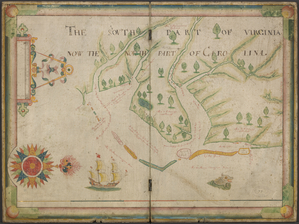Batts, Nathaniell
ca. 1620–ca. 1679
Nathaniell Batts, fur trader, explorer, and early settler, was by 1655 operating a fur trading post in what would be North Carolina.
There seems to be little doubt that Batts was part of the group employed in 1653 and 1654 by Francis Yeardley, prominent planter of Lynnhaven, Va., to establish a fur trade with the Indians to the southward and to explore that region in detail. In 1655, Yeardley sent Robert Bodnam, a carpenter, to the south to build a house twenty feet square (containing two rooms and a chimney) for Batts to live in while he traded with the Indians. The house was erected beside Salmon (then Fletts) Creek at the western end of Albemarle (then Roanoke) Sound. This trading post appears on the Nicholas Comberford map of 1657, entitled "The South Part of Virginia," with the legend "Batts House."
The Comberford map may well reflect the exploration undertaken by the Yeardley group, and much of the information it contains may have come from Batts's explorations. Certainly the frequent appearance of his name on geographical features of the area would so indicate. In 1657 the Virginia General Court acknowledged the great pains and trouble he had taken in his discovery of an inlet to the southward. His discoveries were incorporated in the Comberford map produced in that same year by a well-known member of the "Thames School" of London mapmakers. It was this map that was used by the Lords Proprietors of Carolina in 1663 to delineate the northern boundaries of their province.
For nearly a quarter of a century after the erection of Batts's fur trading post, he divided his time and interest between Carolina and Virginia. On 25 May 1656 he married Mary Woodhouse, a widow with some property; they lived in Lower Norfolk County on the Woodhouse plantation, Roede, which eventually came to be called "Batts Quarters." During the 1650s and probably for a much longer period he was plagued by large debts. When he married Mary Woodhouse, he signed a marriage settlement in which he acknowledged that he was "indebted to some men in Virginia" and promised not to use his wife's property to satisfy any of his debts. In the following year the Virginia General Court gave him as his reward for the discovery of an inlet protection "from all his Creditors within this County for one year & a day." Batts was "frequently involved in litigation over the non-payment of his debts and other matters." Despite his financial problems, he acquired nine hundred acres of land in Nansemond County from Samuel Stephens and later sold the land to Colonel Thomas Francis.
Along with his important interests in Virginia, Batts continued to be heavily involved in Carolina. On 24 Sept. 1660 he purchased from Kiscutanewh, king of the Yeopim Indians, all the land on the west bank of the Pasquotank River from its mouth to the head of New Begin Creek. This transaction, which survives in the records of Lower Norfolk County, Va., is the oldest known surviving North Carolina land deed. Batts also held land in Chowan Precinct on which he lived for a time. His best-known holding was Heriots Island at the mouth of Yeopim River in the Albemarle Sound, which by 1672 was called Batts Island and by the 1690s, Batts Grave.
In 1672, George Fox, founder of the Quaker sect, visited Carolina, met Batts, and visited him at his Chowan plantation. Fox reported that Batts "had been a rude, desperate man" but that he attended some of Fox's meetings and seemed interested in healing by means of prayer. Fox says that Batts "had been Governor of Roanoke" and refers to him as "the Old Governor." No other known source supports such a title, although the possibility that the Virginia government may have placed him in charge of the settlements about Albemarle Sound before 1664 cannot be altogether dismissed.
References:
American Historical Review 45 (1939).
W. P. Cumming, North Carolina in Maps (1966).
Imago Mundi 24 (1970).
North Carolina Historical Review 43 (1966).
Rebel 3 (Spring 1960).
Virginia Magazine of History and Biography 79 (1971).
Additional Resources:
Deed to Nathaniell Batts, 1660, North Carolina Publications Shop, NC Office of Archives & History: http://nc-historical-publications.stores.yahoo.net/9024.html
Hugh T. Lefler, ed., A New Voyage to Carolina by John Lawson (1967).
Elizabeth Gregory McPherson, "Nathaniell Batts: Landholder on Pasquotank River, 1660," NCHR 43 (January 1966).
"Salmon Creek And Eden House: Seedbed Of The Colony." N.C. Highway Historical Marker A-10, N.C. Office of Archives & History. https://www.ncdcr.gov/about/history/division-historical-resources/nc-highway-historical-marker-program/Markers.aspx?sp=Markers&k=Markers&sv=A-10 (accessed March 21, 2013).
Bodnam, Robert (fl. 1650s), A Biogrphical Dictionary of Architects & Builders, NCSU: http://ncarchitects.lib.ncsu.edu/people/P000484
"Nathaniel Batts Land Grant." N.C. Highway Historical Marker A-64, N.C. Office of Archives & History. https://www.ncdcr.gov/about/history/division-historical-resources/nc-highway-historical-marker-program/Markers.aspx?sp=Markers&k=Markers&sv=A-64 (accessed March 21, 2013).
Image Credits:
The Nicholas Comberford map of 1657 shows the house of Nathaniell Batts near the confluence of the Morattico (Roanoke) and Choan (Chowan) Rivers. New York Public Library: http://digitalgallery.nypl.org/nypldigital/dgkeysearchdetail.cfm?trg=1&strucID=744285&imageid=ps_mss_cd18_271&total=1&e=w (accessed March 21, 2013).
1 January 1979 | Mcpherson, Elizabeth G.; Paschal, Herbert R., Jr.
